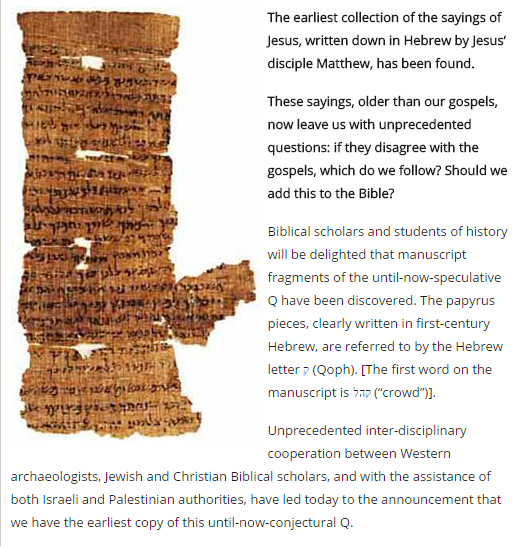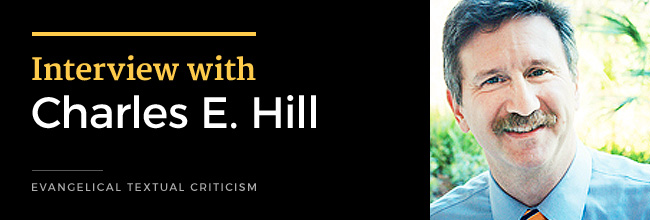In 1973, Eldon J. Epp held a lecture on what he regarded as the “Twentieth Century Interlude in New Testament Textual Criticism” (published in
JBL 93 [1974]: 386–414). He suggested that there had been an interlude ever since the golden era of the 19th century, which had peaked with the work of Westcott and Hort. A few years, Epp published an article in
JBL 98 (1979): 94-98, entitled “New Testament Textual Criticism in America: Requiem for a Discipline,” in which he lamented the contemporary situation of the discipline. The term “interlude,” is of course much more optimistic than “requiem.” The latter suggests the death of the discipline, whereas “interlude” gives hope of resurrection and new life.
Two decades later, it was Larrys Hurtado's turn to describe the field of New Testament textual criticism in an essay, “Beyond the Interlude? Developments and Directions in New Testament Textual Criticism,” in
Studies in the Early Text of the Gospels and Acts (ed. D. G. K. Taylor; Birmingham: University of Birmingham Press, 1999), 26-48. Taking his Doktorvater Epp’s pessimistic survey as the point of departure, Hurtado stated at the outset that Epp’s analysis of the situation was essentially correct, but now he could cite various signs of vigor in the discipline and conclude that things were not as bad any longer. Interestingly, when Epp’s collected essays were published by Brill in 2005, one can read in the notes he had added to his “Twentieth Century Interlude” essay that although he stands by his views in broad terms, he does agree with his PhD student, referring to Hurtado’s essay, that “the ‘interlude’ in recent decades has been undercut by increased interest in the field, significantly larger numbers of participants, numerous text-critical projects and publications, and brighter prospects for the future.”
In this blogpost I would like to mention another important sign that the discipline of New Testament textual criticism is currently beginning to flourish, and that the 21th century might become a new golden era: the representation of textual criticism at international conferences. There are now a number of established units and seminars at various meetings:
1. SBL Annual Meeting
A. New Testament Textual Criticism (chair: Jennifer Knust)
Description: The New Testament Textual Criticism Section seeks to foster the study and criticism of the text of the New Testament—including examination of manuscripts and other sources, restoration of the text, and especially the investigation of the history of its transmission—in its Late Antique cultural context. SBL has had a group dedicated to this topic as far back as 1946.
Call for papers (2016): The NTTC Section is sponsoring two open sessions in 2016: (1) A panel designed to reconsider the periodization of controlled versus fixed New Testament texts. Questions to be considered include: Is it accurate to assume that NT texts, which could be quite fluid early on, became more stable in the post-Constantinian period? Did the identification of particular texts as sacred scriptures impact the transmission of these texts? How? (2) An open panel that welcomes papers on all aspects of the textual transmission of the New Testament. Papers addressing second-century textual traditions, scribal habits, comparative book typology, and the impact of author attribution are especially welcome this year. The Section is also co-sponsoring an invited panel with the International Quranic Studies Association that will compare New Testament and Quranic textual criticism.
B. Novum Testamentum Graecum: Editio Critica Maior (chairs: Holger Strutwolf and Tommy Wasserman)
Description: The unit presents the on-going work on the Editio Critica Maior (ECM), a comprehensive text-critical edition of the Greek New Testament that exhibits the history of the Greek text through its first millennium as documented in manuscripts from the second century until the invention of letterpress printing. It provides scholars engaged in the tasks of exegesis and textual criticism with all the relevant materials found in Greek manuscripts, patristic citations, and early translations. The selection of Greek manuscripts rests on an evaluation of all known primary witnesses, and each of the manuscripts selected is cited completely with all its variants. This opens the way for a new understanding of the history of the text, the more so because all relevant evidence is stored on databases. The primary line of the ECM presents a text based on a careful application of internal and external criteria, streamlined by the Coherence-Based Genealogical Method.
Call for papers (2016): The unit presents the work on a comprehensive edition of the Greek New Testament in the making. New Testament scholars are invited to discuss achievements and goals.
2. SBL International Meeting
Working with Biblical Manuscripts (chairs: Timothy B. Sailors and Ronald van der Bergh)
Description: This program unit is devoted to the text of “biblical” writings, as understood in the broad sense of the term: This includes the Jewish Bible, early Jewish literature, and the Old Testament (in Hebrew and Aramaic, Greek, and other ancient languages), as well as early Christian literature and the New Testament (in Greek, Latin, and other ancient languages). We offer a forum for the investigation of all types of material witnesses related to the text of this literature—tablets, manuscripts, ostraca, inscriptions—and for the consideration of the textual form of this literature reflected in its citation and use by ancient authors and in writings from antiquity through the Middle Ages. This consists not only of contributions that deal with the Hebrew, Aramaic, Greek, and Latin textual witnesses, but also those that engage evidence in Ugaritic, Arabic, Syriac, Ethiopic, Coptic, Armenian, and other linguistic traditions. A wide variety of additional issues related to textual criticism are also addressed, including epigraphy, manuscript studies, papyrology, codicology, paleography, scribal habits and the production of texts, the history of transmission (and its cultural, social, and religious settings), the practice of textual criticism from antiquity to modern times, restoration and conservation, the use of modern technology in studying this material, the production of critical editions, and discussions of particular passages.
Call for papers (2016): Papers concentrating on any aspect of textual criticism are welcome, particularly those that deal directly with manuscripts, i.e., papers that work with material witnesses to the text—tablets, ostraca, inscriptions, papyri, majuscules, minuscules, lectionaries.
3. European Association of Biblical Studies
Textual Criticism of the New Testament, the Old Testament and the Qur’an (chairs: Alba Fedeli and Theodora Panella)
Description: This research group focuses on the textual study and criticism of sacred texts from the ancient Eastern Mediterranean world that later had a global influence; the Old Testament, the New Testament and the Qur’anic text. All three have similarities and differences. They have influenced other writings and at the same time have themselves undergone external influence bearing on questions of interrelationship, orality, textuality and language. Not only the aforementioned characteristics, but also their preservation and the copying as well as the proliferation of manuscripts are of particular interest to textual scholars.
The sine qua non of this research unit for Textual Criticism is the study of the major witnesses to the text of the Old Testament – the Hebrew Bible, the texts from Qumran, the Septuagint, the Masoretic Text – as well as the Aramaic Targumim, the Syriac translations, the Vulgate, Commentaries and others. Of course, also the study of the Critical and the Majority Text, of the versions of the New Testament, as well as the Patristic citations and commentaries, but also Apocrypha and Pseudepigrapha and others. And finally, the research unit includes the textual criticism of the Qur’an, standard text or authoritative text, and the qira’at tradition (that corresponds to different readings); the cultural milieu and context in which the Qur’anic text has been transmitted and used and the tradition of the commentaries.
Call for papers (2016): Two sessions are scheduled for the meeting in Leuven:
- an open session where papers on any topic within the range of the interests of the research group are welcome.
- a thematic session “Do margins matter?” focused on the structure and content of comments, notes, diagrams at the margins of the manuscripts, with the possibility of finding common elements and interactions between the traditions.
The “Textual Criticism of the New Testament, the Old Testament and the Qur’an” research group cordially invites the submission of proposals for papers for the forthcoming EABS meeting in Leuven. Generally the duration of papers to be read should not exceed 20 minutes. Abstracts (no more than 300 words) have to be enrolled through the EABS meeting website until 31st March 2016. More details on dates and abstract submissions please check here.
4. Studiorum Novi Testamenti Societas (SNTS)
New Testament Textual Criticism Seminar (chairs: Claire Clivaz, Ulrich Schmid and Tommy Wasserman)
Rationale: The establishment of the New Testament text is a prerequisite for New Testament studies, and the subsequent history of the text (the textual variants) offers windows into the social history of Christianity and the reception of the text by ancient readers and interpreters. There can never be a strict border between the exegesis of the text and the «Wirkunsgeschichte» as reflected in the history of readings and the study of the NT manuscripts. . . .
New Testament textual criticism has experienced a strong development in recent years and is currently a thriving field of New Testament studies, as evident from the number of publications, including editions (Editio Critica Maior, Nestle-Aland 28, SBLGNT) and electronic tools, as well as a significant increase in activity at scholarly conferences.
The strong development in the digitization of NT manuscripts as undertaken by institutions worldwide, and the perspective of future digital tools and editions such as the forthcoming digital Nestle-Aland 28 strongly points to the necessity to open a new New Testament textual criticism seminar at the SNTS.
Programme (five years):
- Development and diversity of critical editions (2014)
- The history of readings (2015)
- The use of patristic evidence in New Testament textual criticism (2016)
- Digital challenges (2017)
- New Testament textual criticism in exegesis (2018)
5. Birmingham Colloquium on the Textual Criticism of the New Testament (organizers David Parker and Hugh Houghton)
Description: The Birmingham Colloquium on the Textual Criticism of the New Testament is usually held every two years in Birmingham, UK. Since the first meeting in 1997, an ever-increasing number of established scholars as well as doctoral students have participated in the 2-3 day programme. The themes have included scribal practice (2007), patristic citations (2011) and commentaries (2015), as well as broader topics. The colloquium traditionally includes an excursion to examine manuscripts in a local cathedral library and a closing dinner with a presentation. Several sets of proceedings have been published in the ‘Texts and Studies’ series (
http://www.gorgiaspress.com/bookshop/c-44-texts-and-studies-1935-6927.aspx).





















